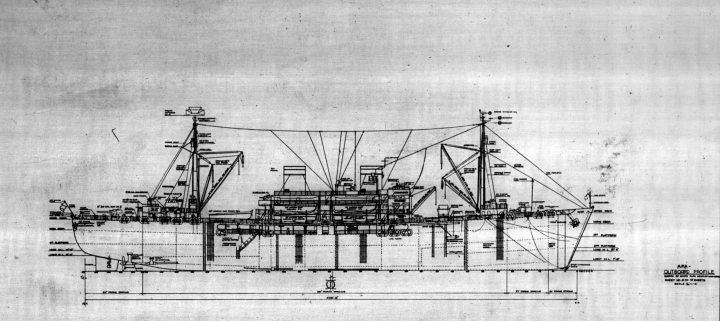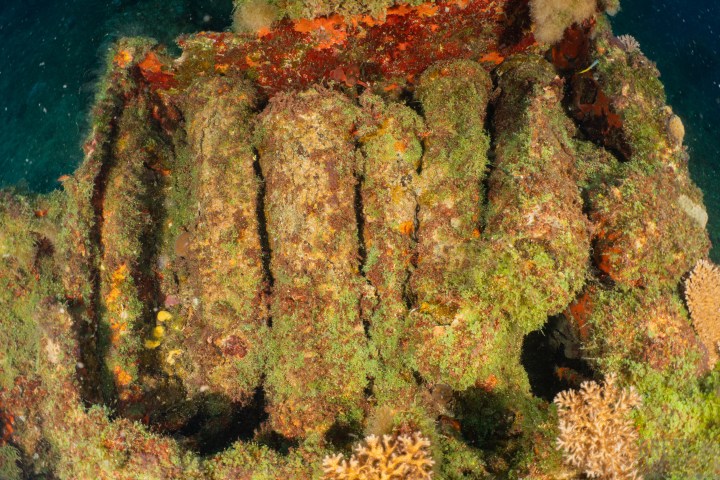
Intro
The USS Carlisle (APA-69) was a Gilliam-class attack transport vessel that served in the Pacific in World War II. She was launched on 30 July 1944 and was built in my “home town” of San Pedro, California. Attack transport vessels are designed to transport invasion forces ashore. As such, they have their own landing crafts and the winches, cranes, etc. The key difference between an attack transport and a landing craft is that attack transports do not beach themselves to get the troops ashore. The attack transport ships also have a variety of armament to protect themselves.
There were a total of 32 Gilliam-class ships built by Consolidated Steel Corporateion of Wilmington, California (close to San Pedro).
The Gilliam-class ships were relatively heavily armed to protect themselves. They typically had 1 x 5″ dual-purpose gun, 4 x twin anti-aircraft radar-directed 40mm guns, and 10 single 20mm anti-aircraft guns. They are 426 feet long and had a beam of 58 feet so it is a relatively large vessel. They were powered by a dual boiler with a turbo-electric transmission and twin-screws. They could carry up to 800 troops and 47 officers and had an complement of 27 officers and 293 enlisted.
I couldn’t find a “clean” copy of the Booklet of General Plans for a Gillaim-class ship, but the outboard profile below will give the reader an idea of the general layout / shape:

The Navy decided to use quite a few of the Gilliam-class ships in the Operation Crossroads tests.
The reason was that they had been designed specifically for wartime use and it wasn’t deemed easy to adapt them to other uses after the end of World War II. Twenty seven (27) of the thirty two (32) vessels were sent to Pearl Harbor in early 1946. Six (6) were decommissioned prior to the atomic tests. Two (the lead ship of the class the Gilliam and the Carlisle) were sunk in the first test (Able) and twelve (12) were damaged and contaminated with radiation and were deliberately sank months later. The remaining seven ships were far outside the blast radius and remained in service for a while.
The photo below is from the Navy.mil site about Gilliam-class ships and shows a few of them at Pearl Harbor before going to Bikini Atoll.
Caption: “A group of prospective target and support ships for Operation Crossroads (the Bikini Atomic Bomb tests) lying at anchor at Pearl Harbor. Ships present from front to rear include Crittenden (APA-77) and several of her sister ships, Catron (APA-71), Bracken (APA-64), Burleson (APA-67), Gilliam (APA-57), Fallon (APA-81), an unidentified ship, Fillmore (APA-83), Kochab (AKS-6), Luna (AKS-7) and an unidentified tanker and liberty ship. This photograph was released on 27 February 1946. (U.S. Navy Photograph 80-G-702126, National Archives and Records Administration, Still Pictures Division, College Park, Md.)”

The Carlisle
The Carlisle served in the Pacific during WW II and made a few round trips between San Diego and Pearl Harbor carrying sailors, Marines, and cargo. She then transported Marine units among the Hawaiian Islands. As far as I can tell, she never saw action or participated in any combat missions.

In the Diagram Below, the Gilliam is target #5 only 50 yards from the epicenter of the blast and the Carlisle is target #4 and was 430 yards away from the center. Both were sunk during the Able test.

The Wreck & Photos
Given how close the Carlisle was to the epicenter, she sustained a lot of damage during the blast. She was displaced about 50 yards from her location prior to the blast. It toppled the stacks and mainmast and damaged quite a lot of the wreck. She and about 30 minutes after the detonation. There are a few key areas of interest on the wreck including the guns, a cool wheel which I’m not sure what it belongs to, both large props, some spare props that are smaller so they must have been for landing craft, and some ammunition. It isn’t a “highly rated” wreck in Bikini but well worth a dive.












References
Wikipedia Gilliam-class article
Navy.Mil site on Gilliam-class
